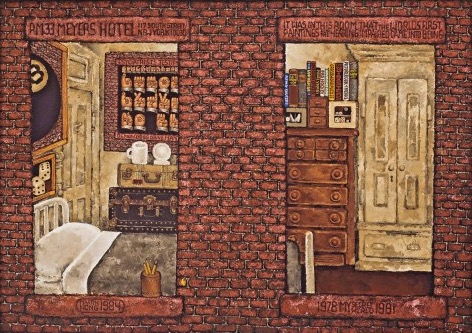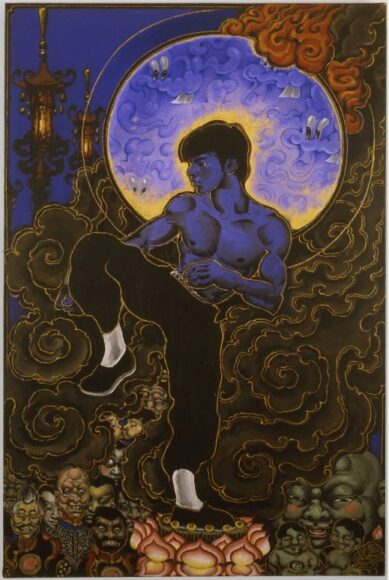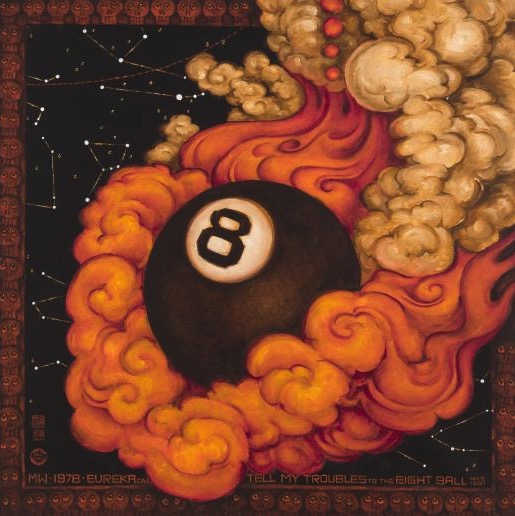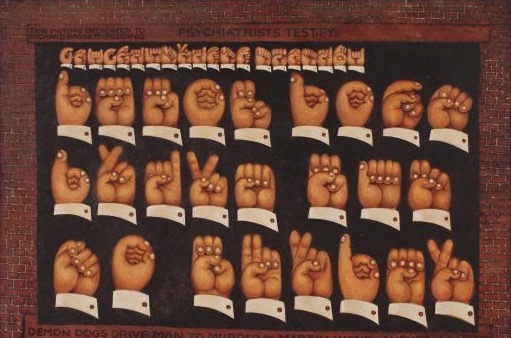
Do you remember Tracey Emin getting drunk on television? It was 1997, at the Turner prize. A group of arty men — including me — had come together to debate “Is painting dead?” The discussion was prompted by an article I had written in defence of Emin in this paper in which I argued that painting was no longer the only way to make art — it was merely one way.
I thought the piece was carefully nuanced. But the subs gave it the bold headline “Is painting dead?” and everyone assumed I was anti-painting when the opposite was true. Today, Emin getting drunk is remembered as one of TV’s finest moments. No one remembers what we were discussing.
It flashed past me again as I made my way round the exceptionally brilliant Martin Wong exhibition that has lit up the Camden Art Centre. The best show I have seen in many a blue moon, it felt extra punchy because I had never heard of Martin Wong (1946-99). Why? Because he was a painter in an era when painting was deemed passé, uncool, irrelevant and, yes, dead.

The son of wealthy Chinese-American laundry owners, Wong grew up in San Francisco in the hippy era. East coast America never did take west coast America seriously. Not in art. Funny, emotional, subversive, gay — Wong was too rich a cake for the monkish greyfriars of the New York art world to nibble. So he made his own way. And did it thrillingly.
We start in flower-power Haight-Ashbury with a mood-setting wonky film featuring an experimental “theatre group” dancing round a meadow: the girls take off their tops, the guys smear war paint on their faces and make like Chingachgook. As you watch them prancing you can smell marijuana seeping out of the telly. What fun it must have been.
Wong had an early go at sculpture — with some wobbly ceramics of hybrid monsters — and dabbled also with calligraphic poetry, but settled on painting, thank Buddha. His hippy pictures have something surprisingly deep about them. Even the “tantric” images of multiheaded goddesses surrounded by grinning skulls — they would have made superb album covers for the Grateful Dead — have a prickly seriousness to them. Having inherited an ease with the cosmic from his Chinese background, he was never as silly, dippy, flippy or slight as the crowd he ran with.
One of the reasons the show is so special is because of the growth you feel from room to room. The 1960s hippy paintings are intriguing. But Wong’s next step, his art of the 1970s, is something else: a step into greatness.

Two things appear. One is the use of cryptic symbols discovered in lowly corners of real life, but given a cosmic heft in his pictures. The paintings featuring the eight ball surely refer to life and its vicissitudes — no one in pool wants to be stuck behind the eight ball. But by enlarging this trashy symbolism with big astrological ideas Wong magics pop art materials into something sensuous and sublime.
The other discovery is American Sign Language (ASL). After a chance encounter with a deaf person in the street, who handed him a guide to the ASL alphabet, Wong began using it in his art. Various hand signs spell out assorted phrases and titles. It’s a way of painting words that is simultaneously secret and direct (if you know the code). It also harks back to the sacred finger language of Byzantine art, where the arrangement of Christ’s hand conveyed specific religious meanings. And because the gesture for “T” is the same as the Turkish fig sign, it’s furtively comic and brings sex to the table.
The mysterious ASL paintings feel like a high point, but they’re just a start. In 1978 Wong moved to New York, where he settled in the decrepit Lower East Side and watched it burn. This was New York’s savage season, when the pavements were full of drug addicts, cars were set alight in the street, the rubbish stayed uncollected and the poor rioted.

You’d never know it from the cool, grey minimalism favoured by the Manhattan art world at the time, but it’s unmissable in Wong’s extraordinary record of the moment. That’s the thing about painting. When things get real, it’s what you reach for.
In a set of stunningly atmospheric depictions of the Lower East Side smouldering, he captures the bricky desolation of the times, the fire, the ruins, while opening a secret door to his own darkness: the loneliness of the hermetic little world in which he was cooped up. In the pantheon of Manhattan depictions, this art deserves to be ranked alongside Edward Hopper, George Bellows and Frank Stella. It’s that good.
Yet still he goes on. A series of prison pictures featuring the drug peddlers and urban poets he’d fallen in with in the Puerto Rican neighbourhood in which he lived take the show on to yet another level of potency and difference. Gazing through the bars at the dodgy love interests for whom he had a taste — criminals, pushers, firemen — Wong achieves the undoable: he makes something plangent and poetic out of the grim prose of the lock-up.
In 1994 he was diagnosed with Aids and returned to San Francisco, and his family home, where his art shifted suddenly again to Chinese subjects. Portraits of Bruce Lee and, of all people, Patty Hearst, whom he imagines as the machinegun-toting Hindu goddess Kali, are once again garishly tantric, yet packed with whispery symbolism. The Patty Hearst was his last painting, finished on the day he died, August 12, 1999.
Spectacularly different to the end, Wong had one of the great American art careers. I can’t believe I missed it.
Martin Wong: Malicious Mischief, Camden Art Centre, London NW3, until Sep 17
